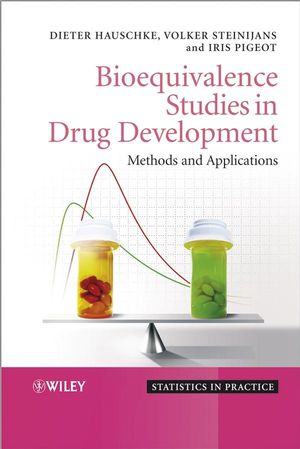Bioequivalence Studies in Drug Development: Methods and ApplicationsISBN: 978-0-470-09475-4
Hardcover
304 pages
February 2007
 This is a Print-on-Demand title. It will be printed specifically to fill your order. Please allow an additional 10-15 days delivery time. The book is not returnable.
|
||||||
1 Introduction.
1.1 Definitions.
1.2 When are bioequivalence studies performed.
1.3 Design and conduct of bioequivalence studies.
1.4 Aims and structure of the book.
References.
2 Metrics to characterize concentration-time profiles in single- and multiple-dose bioequivalence studies.
2.1 Introduction.
2.2 Pharmacokinetic characteristics (metrics) for single-dose studies.
2.3 Pharmacokinetic rate and extent characteristics (metrics) for multiple-dose studies.
2.4 Conclusions.
References.
3 Basic statistical considerations.
3.1 Introduction.
3.2 Additive and multiplicative model.
3.3 Hypotheses testing.
3.4 The RT/TR crossover design assuming an additive model.
References.
4 Assessment of average bioequivalence in the RT/TR design.
4.1 Introduction.
4.2 The RT/TR crossover design assuming a multiplicative model.
4.3 Test procedures for bioequivalence assessment.
4.4 Conclusions.
References.
5 Power and sample size determination for testing average bioequivalence in the RT/TR design.
5.1 Introduction.
5.2 Challenging the classical approach.
5.3 Exact power and sample size calculation.
5.4 Modified acceptance ranges.
5.5 Approximate formulas for sample size calculation.
5.6 Exact power and sample size calculation by nQuery®.
References.
Appendix.
6 Presentation of bioequivalence studies.
6.1 Introduction.
6.2 Results from a single-dose study.
6.3 Results from a multiple-dose study.
6.4 Conclusions.
References.
7 Designs with more than two formulations.
7.1 Introduction.
7.2 Williams designs.
7.3 Example: Dose linearity study.
7.4 Multiplicity.
7.5 Conclusions.
References.
8 Analysis of pharmacokinetic interactions.
8.1 Introduction.
8.2 Pharmacokinetic drug-drug interaction studies.
8.3 Pharmacokinetic food-drug interactions.
8.4 Goal posts for drug interaction studies including no effect boundaries.
8.5 Labeling.
8.6 Conclusions.
References.
9 Population and individual bioequivalence.
9.1 Introduction.
9.2 Brief history.
9.3 Study designs and statistical models.
9.4 Population bioequivalence.
9.5 Individual bioequivalence.
9.6 Disaggregate criteria.
9.7 Other approaches.
9.8 Average bioequivalence in replicate designs.
9.9 Example: The anti-hypertensive patch dataset.
9.10 Conclusions.
References.
10 Equivalence assessment in case of clinical endpoints.
10.1 Introduction.
10.2 Design and testing procedure.
10.3 Power and sample size calculation.
10.4 Conclusions.
Apendix.
References.
Index.



